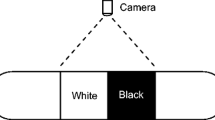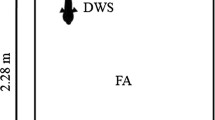Abstract
Substrate preferences of juvenile, hatchery-reared lake sturgeon, Acipenser fulvescens, from a Wisconsin population were examined relative to water temperature and velocity, fish size and time of day. Given the choice of a sand, gravel, rock or smooth plastic bottom, all sturgeon were strongly attracted to the sand substrate. Water temperature did not affect substrate preference, however small sturgeon (13.5 cm mean FL) acclimated to 19°C were more active than those tested in 6°C water. Small sturgeon, under all conditions, were less sedentary in the early morning and late evening hours than during the daytime. Preference of small sturgeon for sand was slightly stronger when a current of 5 cm sec-1 was present. Substrate preference of larger sturgeon (24.3 cm mean FL) was not affected by any of the parameters examined. In general, hatchery-reared lake sturgeon showed similar behaviors (with respect to substrate selection) as those previously described for the same population in the wild, making it possible that substrate preferences have a genetic component and likely that hatchery rearing does not alter instinctive behavior.
Similar content being viewed by others
References cited
Auer, N.A. 1996. Importance of habitat and migration to sturgeons with emphasis on lake sturgeon. Can. J. Fish. Aquat. Sci. 53: 152–160.
Bennett, W.R. & A.P. Farrell. 1998. Acute toxicity testing with juvenile white sturgeon, Acipenser transmontanus. Water Qual. Res. J. Canada 33: 95–110.
Boeuf, G. & J.L. Gaignon. 1989. Effects of rearing conditions on growth and thyroid hormones during smoltification of Atlantic salmon, Salmo salar. Aquaculture 82: 29–38.
Chan, M.D., E.D. Dibble & K.J. Kilgore. 1997. A laboratory examination of water velocity and substrate preference by age-0 Gulf sturgeons. Trans. Amer. Fish. Soc. 126: 330–333.
Crocker, C.E. & J.J. Cech, Jr. 1997. Effects of environmental hypoxia on oxygen consumption rate and swimming activity in juvenile white sturgeon, Acipenser transmontanus, in relation to temperature and life intervals. Env. Biol. Fish. 50: 383–389.
Ferguson, M.M. & G.A. Duckworth. 1997. The status and distribution of lake sturgeon, Acipenser fulvescens, in the Canadian provinces of Manitoba, Ontario and Quebec: a genetic perspective. Env. Biol. Fish. 48: 299–309.
Fleming, I.A., B. Jonsson & M.R. Gross. 1994. Phenotypic divergence of sea-ranched, farmed, and wild salmon. Can. J. Fish. Aquat. Sci. 51: 2808–24.
Houston, J.J. 1987. Status of the lake sturgeon, Acipenser fulvescens, in Canada. Can. Field Nat. 101: 171–185.
Jennings, M.J., J.E. Claussen & D.P. Philipp. 1996. Evidence for heritable preferences for spawning habitat between two walleye populations. Trans. Amer. Fish. Soc. 125: 978–982.
Kazakov, R.V. & V.V. Kozlov. 1985. Quantitative estimation of degree of silvering displayed by Atlantic salmon, Salmo salar, juveniles originating from natural populations and from fish-rearing farms. Aquaculture 44: 213–220.
Kempinger, J.J. 1988. Spawning and early life history of lake sturgeon in the Lake Winnebago system, Wisconsin. Amer. Fish. Soc. Symp. 5: 110–122.
Kempinger, J.J. 1996. Habitat, growth and food of young lake sturgeons in the Lake Winnebago system, Wisconsin. N. Amer. J. Fish. Man. 16: 102–114.
Levin, A.V. 1988. Characteristics and feeding behaviour of juvenile Russian sturgeon, Acipenser gueldenstaedti, in relation to food availability. Voprosy Ikhtiologii 1: 110–116 (in Russian).
Liu, H., Y. Sakurai, H. Munehara & K. Shimazaki. 1997. Diel rhythms of oxygen consumption an activity level of juvenile flounder Paralichthys olivaceus. Fisheries Science 63: 655–658.
Loew, E.R. & A.J. Sillman. 1998. An action spectrum for the light-dependent inhibition of swimming behaviour in newly hatched white sturgeon, Acipenser transmontanus. Vision Res. 38: 111–114.
Miyazaki, T., R. Masuda, S. Furuta & K. Tsukamoto. 1997. Laboratory observation on the nocturnal activity of hatchery-reared juvenile Japanese flounder Paralichthys olivaceus. Fisheries Science 63: 205–210.
Parsley, M.J. & L.G. Beckman. 1993. Spawning and rearing habitat use by white sturgeons in the Columbia River downstream from McNary Dam. Trans. Amer. Fish. Soc. 122: 217–227.
Parsley, M.J. & L.G. Beckman. 1994. White sturgeon spawning and rearing habitat in the lower Columbia River. N. Amer. J. Fish. Man. 14: 812–827.
Peake, S., F.W.H. Beamish, R.S. McKinley, D.A. Scruton & C. Katopodis. 1997. Relating swimming performance of lake sturgeon, Acipenser fulvescens, to fishway design. Can. J. Fish. Aquat. Sci. 54: 1361–1366.
Rochard, E., G. Castelnaud & M. LePage. 1990. Sturgeons (Pisces: Acipenseridae); threats and prospects. J. Fish Biol. 37(Supplement A): 123–132.
Sbikin, Y.N. & N.I. Bibikov. 1988. The reaction of juvenile sturgeons to elements of bottom topography. Voprosy Ikhtiologii 3: 473–477 (in Russian).
Author information
Authors and Affiliations
Rights and permissions
About this article
Cite this article
Peake, S. Substrate Preferences of Juvenile Hatchery-reared Lake Sturgeon, Acipenser fulvescens . Environmental Biology of Fishes 56, 367–374 (1999). https://doi.org/10.1023/A:1007523607190
Issue Date:
DOI: https://doi.org/10.1023/A:1007523607190




